|
Google™ Image Search service helps reconstruct
colonial architecture in Bolivia
by
Shahid Mujtaba & Beatriz Escobar-Mujtaba |
[En_Espanol] |
|
| Thanks to a picture found through Google™ Image
Search service, the tower and parish building
of the Church of San Salvador in Totora, a Colonial City of Bolivia, were
reconstructed according to the historical colonial architecture of the golden
era of the City. |
|
|
Demolishing the New and Reconstructing the Old
|
|
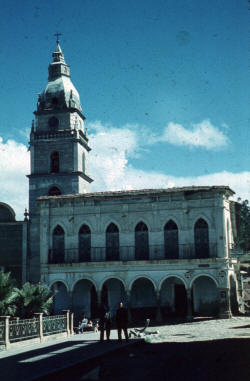 |
|
|
1959, The Church and
Pozo family residence, by Prof Hans Ross. |
|
TOTORA is a Colonial City
in the Department of Cochabamba,
Republic
of Bolivia. In the mid 1950s, the majority of its
inhabitants left Totora in search of a better life
because the economy changed due to the opening of the
new Cochabamba – Santa Cruz highway that
bypassed the city, and also because of the Land Reform
of 1952.The webmaster of
totora.org,
when researching material for the site, used Google™
Image Search ih service for pictures of the city,
and found one of the tower of the Church of San
Salvador (patron saint of Totora), and an adjacent
building belonging to the Pozo family. The picture was
from a
photograph taken in 1959 by Prof Hans Ross,
et al during a
Botanical Andean Potato Expedition, and
part of the
online library of Prof.
Kurt Stüber of the Max Planck Institute in Germany.
Herminia Escobar Q, a Totoreña proud of her Totora
roots, saw the photograph on a trip to California and
recognized the façade of the church and tower as being
those of her youth. She proudly showed an 8"x10" print
during a meeting of the Mayor and the members of the
City Council to share a piece of history. The Council
members decided to demolish the newly renovated parish
building and replace the façade so that it looked like
it did in the past. The official dedication and opening of the completed
church and parish occurred on November 12,
2006. Reverend Monsignor Ivo Scápolo, Apostolic Nuncio
of the Sanctity Pope Benedict XVI, presided over the
Consecration ceremony. Pictures of the occasion
are available
here,
here and
here. |
|
|
Changes to the Tower and Discontent of San Salvador
The
original tower before 1959 was located between two private
residences. The bells chimed on the quarter hour and
tolled on the hour and the melody could be heard for several
Kilometers around the city, and together with the clock provided
the official time standard. Beatriz Escobar, another
Totoreña, recalls the beauty of the tower and the harmonious
melody of the bells.
Along with the modernization of the customs of the
Catholic religion, the Priests in charge of the Parish
replaced the tower and its façade with a more modern
appearance, and the adjacent Pozo residence with a red
Parish building |
|
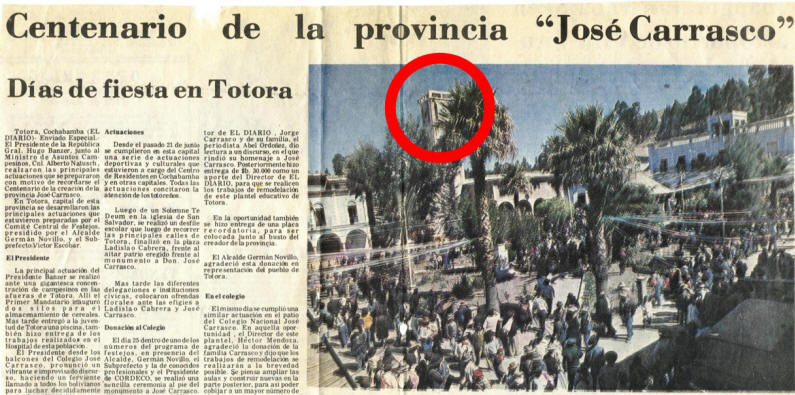 |
|
1976, Church Tower with flat
top, Newspaper Clipping |
This change without public review or discussion caused
widespread discontent. A newspaper clipping at the time of the Centennial
celebration of the city in 1976 showed the tower with a flat
top. That same article criticized the design, and many believed
that
San Salvador, the Patron Saint of Totora, was not pleased
with the modern design.
Later pictures show the tower was a rectangular structure with a
pyramid top, rather than the gentle tapering structure with
gently curved top of the original. The modern tower is shown in
these photographs by Jose Novillo in his book.
|
|
|
|
Photos showing the pyramid top
of the tower, by Jose Novillo |
| Two earthquakes (of magnitudes 5.9 and 6.3 on the Richter
scale thirteen minutes apart) that struck Bolivia’s Carrasco
province on May 22, 1998 hit Totora very hard. Colonial
residences made of wide adobe blocks withstood the tremors,
while the newly modernized brick and concrete homes and
buildings suffered the most damage.
Among the most damaged structures were the modern church tower
and the Parish building. The statues of the saints, except that
of San Salvador, toppled from their pedestals and suffered
cracks. After falling off the Main Altar, the statue of San
Salvador landed upright on its feet. Although it stood on the
highest pedestal in the church, it suffered only a broken
finger, otherwise surviving intact. The faithful believed that
our Niño was not content with the modern temple, and wanted it
rebuilt according to the original design.
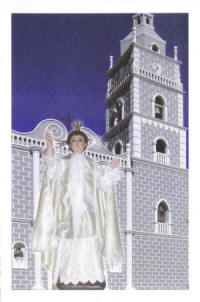 |
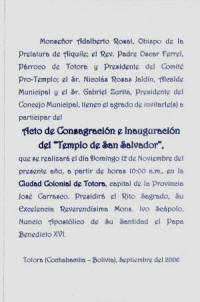 |
|
Announcing the Official Inauguration of
the
Church of San Salvador on November 12, 2006 |
Totoreños around the
world felt great sorrow at the tragedy. Recognizing their
birthplace was calling upon its children, they responded with
overwhelming support. Although reconstruction was not easy, the
unwavering push of committee members and the generous outpouring
of aid from Totoreños and other well-wishers made the
reconstruction a reality and brought to life the melody of the
bells. Totoreños living in Virginia, Texas and California in the
US contributed not only for reconstruction of the tower, but
also for the altars and statues. They contributed funds to
construct the altar of individual saints in memory of some
dearly departed loved one or family member. The website
www.totora.org shows progress of the church reconstruction at
various times. On November 12, 2006 the statues of all the
Saints were on display in full glory for the first time. The
Church is now as beautiful as before, and our Niño is finally
content with his new church.
On behalf of Totoreños, a big Thanks to the Committee Pro
Templo. |
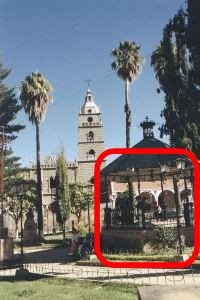 |
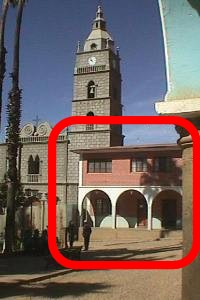 |
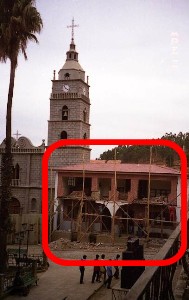 |
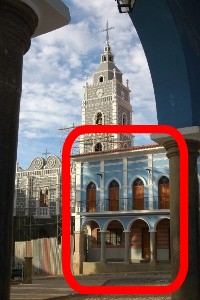 |
|
June
2002, tower and parish rebuilt after the earthquake, by
Jose Caero. |
April 25, 2003, Parish
Building, by Herminia Escobar |
November 2003, Renovated Parish Building being torn
down, by Herminia Escobar |
September 2005, Reconstructed Parish
Building being built, by Roberto Escobar |
|
|
| Three Niños Re-unite!
During the annual feast
of San Salvador in the first two weeks of the New Year in
Totora, the townspeople pay respect to their patron saint.
Native Totoreños return from distant places, and many joyful
reunions occur among people who have not seen one another for
years. During that time, the Niño from the church and several
other statues belonging to individuals go in procession from the
church, around the plaza, and then from residence to
residence, where the clothes are carefully and lovingly changed,
and they stand in places of honor among flowers and candles.
A newly
revived historical tradition is the adoration ceremony, where
people dress up as
different characters, and recite their lines. Highlighting the ceremony is a visit of the statues to the “Calvario”,
a chapel on the steep hillside on the outskirts of the town.
Beatriz Escobar recalls from her childhood
days that on Calle Cochabamba, the street where she lived, there
were two private statues of San Salvador. One belonged to
the Terceros family, and the other to the Novillo family. These
two and the one in the church always participated in the
festivities every year. When the Terceros family members
left for La Paz and Cochabamba,
they left the statue in Totora for the traditional celebration
to continue, and came back for the festivities every year.
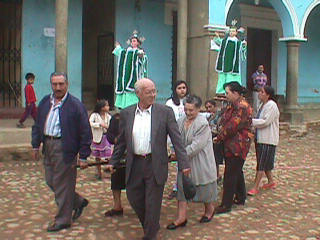 |
| January 1999, Two Niños in procession around the Plaza,
by Shahid Mujtaba. |
The Novillo family statue (the more popular
of the two) went with the family to Cochabamba, much to the
dismay and disappointment of the townspeople, who felt that it
belonged to the city. For a long time, the processions only had
these two major statues (the church and the Terceros statue)
during the celebration of the feast.
In 2005, the Novillo family statue came back to Totora, and is now resident in the church. Details of the return will be provided at a later date.
During a visit in the late 1990s, the webmaster observed that during
the festivities, two large statues were in procession (one from the church, and
the other from the Terceros family) together with some smaller statues that
appeared and disappeared from year to year. In recent years, the three Niños are
together, and the faithful are happy that they were re-united. They know that the three
playful Niños, who enjoy the love and attention of their devoted worshippers,
and the celebration and partying around them, were instrumental in arranging for the joyful
reunion so that together they may look over and protect the city and its residents.
|
|
|
Private Traditions Around
the World
Around the time of the feast
of San Salvador in Totora, Totoreños around the world hold their own ceremonies
(although not for the one or two week celebration) in their private residences,
and hope to make it an annual tradition for those who cannot go back to the
original site. In 2006, instance, Beatriz Escobar held a mass and celebration
in Milpitas, California.
|
|
| |
| |
|
|
| |
| |
| |
|